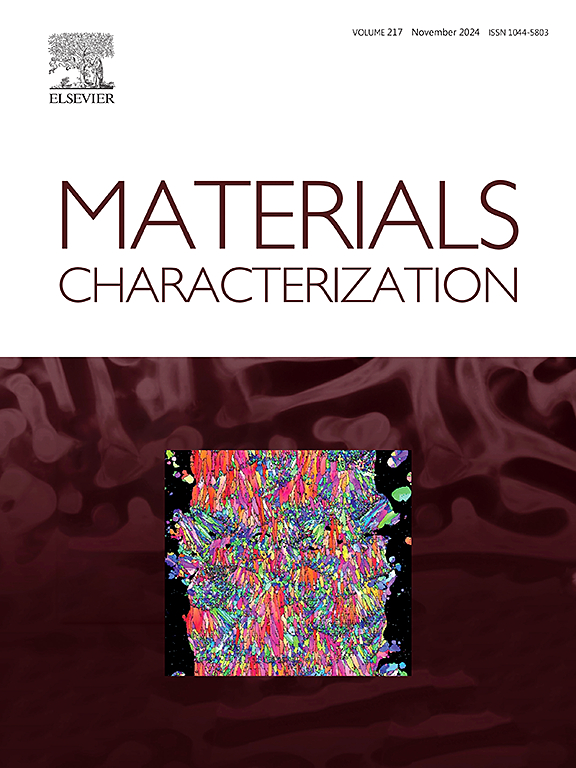Effect of heat treatment on microstructural evolution of Electron beam welded additive IN718
IF 4.8
2区 材料科学
Q1 MATERIALS SCIENCE, CHARACTERIZATION & TESTING
引用次数: 0
Abstract
High energy density welding processes like the electron beam welding (EBW) has the capability of generating precise and narrow welds free from defects, making it a reliable process for welding critical aerospace components. In this work, a study of microstructure evolution in additively manufactured IN718 subjected to pre- and post-weld heat treatment is done. The as-built microstructure generated during the laser powder bed fusion (LPBF) process has overlapping melt pool with interdendritic segregation and Laves phase formation. The melt pool region in as-built condition has a wider sub-grain width (360 to 560 nm) with cellular structure in comparison to an overlapped region having (200 to 330 nm) columnar sub-grain structure. Lower heat input and faster cooling rate complemented by beam oscillation in the EBW process suppressed Nb segregation, generating discontinuous Laves phase in the weld region. Three solution treatment (ST) temperatures are selected: 1180 °C, 1065 °C, and 980 °C. Solution heat treatment at 1180 °C−1 h/AC dissolved segregates back to matrix and caused recrystallization. However, solution treatment at 1065 °C−1 h/AC and 980 °C−1 h/AC retained columnar texture with dissolution of segregates. There is appreciable variation in microhardness between the base metal and weld region, which has been correlated with precipitation of phases like Laves, δ phase, γ″ and γ', their composition and distribution, as well as the effect of grain size. The post-weld solution treatment carried out at 980 °C−1 h/AC led to the precipitation of δ phase (3.29 % by volume) at the sites of dissolved Laves phase in the weld region, lowering the availability of Niobium in the matrix for precipitation of γ″ and γ' during double aging treatment, reducing microhardness in the weld region.
热处理对电子束焊接添加剂IN718组织演变的影响
像电子束焊接(EBW)这样的高能量密度焊接工艺能够产生精确且无缺陷的窄焊缝,使其成为焊接关键航空航天部件的可靠工艺。本文对增材制造IN718在焊前和焊后热处理过程中的组织演变进行了研究。激光粉末床熔合过程中产生的原位组织具有重叠熔池、枝晶间偏析和Laves相形成。与具有(200至330 nm)柱状亚晶结构的重叠区域相比,建成条件下的熔池区域具有更宽的亚晶宽度(360至560 nm)和细胞结构。较低的热输入和较快的冷却速度加上电子束振荡抑制了Nb偏析,在焊缝区域产生不连续的Laves相。三种固溶处理(ST)温度选择:1180°C, 1065°C和980°C。在1180°C - 1 h/AC固溶热处理时,溶解偏析回基体并引起再结晶。然而,在1065°C−1 h/AC和980°C−1 h/AC固溶处理时,随着偏析的溶解,仍然保留柱状织构。母材与焊缝区的显微硬度有明显的变化,这与Laves、δ相、γ″和γ′相的析出、组成和分布以及晶粒尺寸的影响有关。在980°C−1 h/AC下进行焊后固溶处理,导致焊缝区溶解的Laves相处析出δ相(体积比3.29%),降低了基体中铌在双时效处理中析出γ″和γ′的有效性,降低了焊缝区的显微硬度。
本文章由计算机程序翻译,如有差异,请以英文原文为准。
求助全文
约1分钟内获得全文
求助全文
来源期刊

Materials Characterization
工程技术-材料科学:表征与测试
CiteScore
7.60
自引率
8.50%
发文量
746
审稿时长
36 days
期刊介绍:
Materials Characterization features original articles and state-of-the-art reviews on theoretical and practical aspects of the structure and behaviour of materials.
The Journal focuses on all characterization techniques, including all forms of microscopy (light, electron, acoustic, etc.,) and analysis (especially microanalysis and surface analytical techniques). Developments in both this wide range of techniques and their application to the quantification of the microstructure of materials are essential facets of the Journal.
The Journal provides the Materials Scientist/Engineer with up-to-date information on many types of materials with an underlying theme of explaining the behavior of materials using novel approaches. Materials covered by the journal include:
Metals & Alloys
Ceramics
Nanomaterials
Biomedical materials
Optical materials
Composites
Natural Materials.
 求助内容:
求助内容: 应助结果提醒方式:
应助结果提醒方式:


